Content
- 1 What is Savoy cabbage
- 2 Varieties included in the State Register
- 3 Planting savoy cabbage
- 4 Growing features
- 5 Cleaning and storage
- 6 Reviews
- 7 Savoy cabbage varieties
- 8 Savoy cabbage growing
- 9 Plant care
- 10 Features of growing savoy cabbage in the regions
- 11 Reviews
- 12 Features of savoy cabbage
- 13 Savoy cabbage cultivation
- 14 Savoy cabbage care
- 15 Savoy cabbage harvesting and storage
- 16 Savoy cabbage varieties
- 17 Savoy cabbage diseases
- 18 Disease control methods
- 19 Savoy cabbage pest control
- 20 Question answer
It is rare to find a plot where cabbage is not grown at all. Most often, gardeners plant white cabbage. However, there are other varieties, for example, its relative - Savoy cabbage, which also belongs to the type of Cabbage.
What is Savoy cabbage
Like the usual white cabbage, Savoy cabbage has large heads of cabbage, but their structure is loose, and the leaves are thin and corrugated.
Although Savoy cabbage is cold-resistant and therefore suitable for the Russian climate, it is not very common in our country. Probably, this is the case because of the yield, which is not high in comparison with the white one. There is another disadvantage - Savoy cabbage cannot be fermented. However, it tastes better, softer than traditional cabbage and is perfect for salads, stews, soups and pie filling.
The nutritional value
Savoy cabbage is not only tasty, but also healthy:
- Compared to other types of cabbage, it contains more vitamins and minerals, such as phosphorus and calcium;
- a significant amount of potassium has a good effect on the heart and blood vessels;
- vitamin C in it is not less than in citrus;
- rare vitamin U is also found in savoy cabbage;
- there is practically no starch and sucrose in it, which is good for diabetics;
- Savoy cabbage contains a lot of fiber and is therefore suitable for dieters.
Due to its high fiber content, Savoy cabbage is not recommended for people with gastritis, pancreatitis and gastrointestinal ulcers, as well as for those who have recently undergone surgery in the chest or abdomen.
Table: Nutritional value of Savoy cabbage (per 100 grams)
Video: useful properties of savoy cabbage
Varieties included in the State Register
Many growers produce Savoy cabbage planting stock, and there is no unequivocal opinion which one is better. General recommendations for selection are as follows:
Consider the most popular varieties of Savoy cabbage, registered in the State Register of Breeding Achievements.
Early ripe
Early ripening varieties ripen in 105–120 days. They are suitable for eating fresh or frozen.
- Gold early. High-yielding cabbage with dark green heads weighing 800 grams. Resistant to cracking. Ripens in 90-110 days.
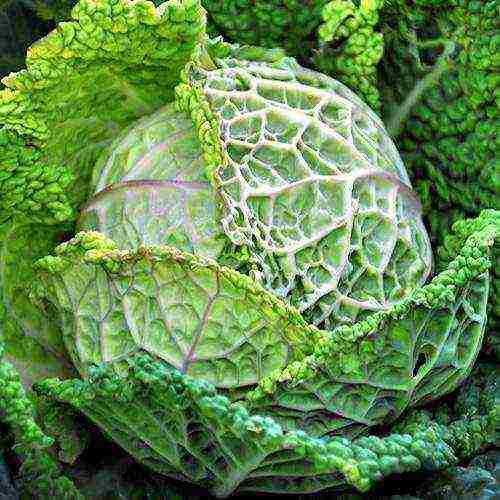
Cabbage variety Zolotaya early has strong corrugated leaves
-
Jubilee 2170. Early ripening cabbage, ripens in 85-110 days. Heads of cabbage are light green, grayish, weighing up to 800 grams. Prone to cracking.
- Petrovna. Heads of cabbage are dark green on the outside, and light yellow inside, the weight of one is slightly more than a kilogram. Ripens in 100-110 days.
- Moscow lacemaker. An early ripening variety with light green blistery leaves with a slight waxy bloom and heads of cabbage weighing about 1 kg. The taste is excellent.
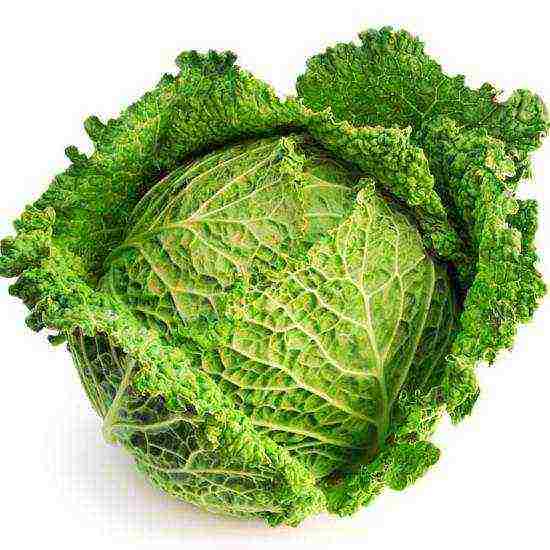
Cabbage variety Moscow lacemaker has a beautiful appearance
Mid-season
Mid-season varieties ripen in 120–135 days. These include:
- Twirl 1340. The heads of cabbage are medium in size, with strongly corrugated leaves, reaching a weight of 2.5 kg. The cabbage tastes good, but it is not suitable for long-term storage.
- Uralochka. Leaves are strongly knotty, slightly wavy, light green, heads of cabbage weighing about 1 kg.
- Melissa. Heads of cabbage are dark green, weigh on average 2-3 kg. This cabbage tastes good and can be stored for 4-5 months in addition.
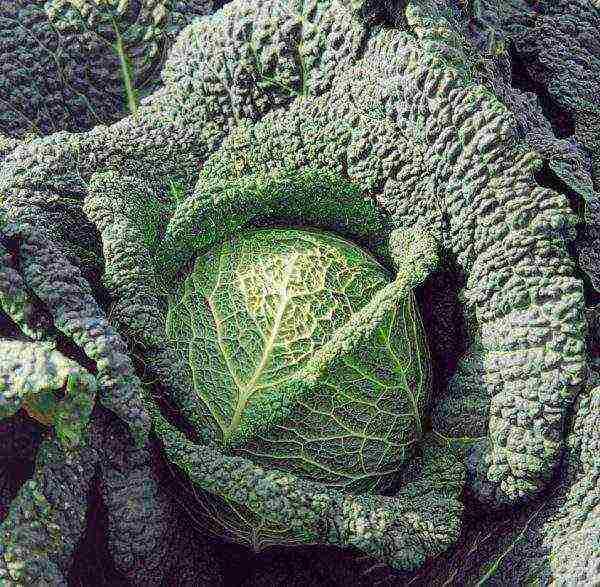
Melissa cabbage is a hybrid, therefore it has an F1 prefix to its name
Late ripening
Late-ripening varieties of Savoy cabbage reach maturity in 140 days or more. They are believed to be best suited for winter storage.
- Nadia. The heads of cabbage are gray-green in color, weighing about 1 kg, the leaves are wrinkled and blistery. Cabbage has a high taste, but not very well stored.
- Viros. Heads of cabbage are medium-sized, weighing 1.8–2.5 kg, blue-green in color, with highly bubbly leaves covered with a waxy coating. Cabbage of this variety is suitable for long storage.
- Alaska. Heads of cabbage are gray-green, weight of one on average is 2.3 kg. The leaves are wavy, with a strong waxy bloom. Cabbage has an excellent taste and is suitable for long-term storage.
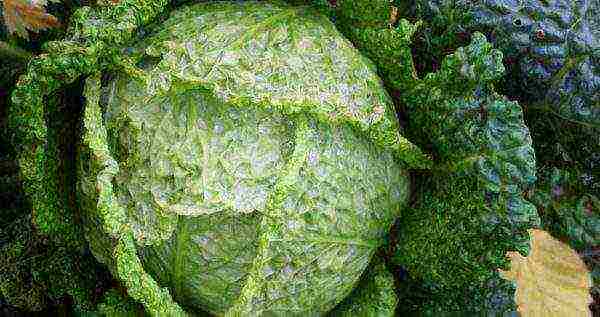
Alaska cabbage is suitable for long-term storage
Planting savoy cabbage
Seeds of early varieties are sown for seedlings in the second decade of March, and of middle and late varieties - in the second decade of April..
Sowing seedlings
Sowing is done as follows:
- Prepare the soil by mixing equal proportions of turf, sand and peat. You can also buy ready-made soil.
- It is advisable to disinfect the earth with a solution of potassium permanganate.

Before planting, it is advisable to subject the seeds to standard processing: calibration, disinfection in a solution of potassium permanganate or in another way, as well as their hardening
- Plant seeds in moist soil to a depth of 1 cm.
- Cover crops with glass (some use polyethylene).
- Provide temperature up to 20 C, preferably 18 C
- On average, seedlings appear in 5-7 days.
- With the emergence of sprouts, the temperature is reduced to 8–10 C days. In the case of a higher t, the plants are too elongated.
- The sprouts are freed from the shelter and placed in a bright place.
- In face 1 of this leaf, the temperature can be increased to 13-14 ºC during the day and 10-12 ºC at night.
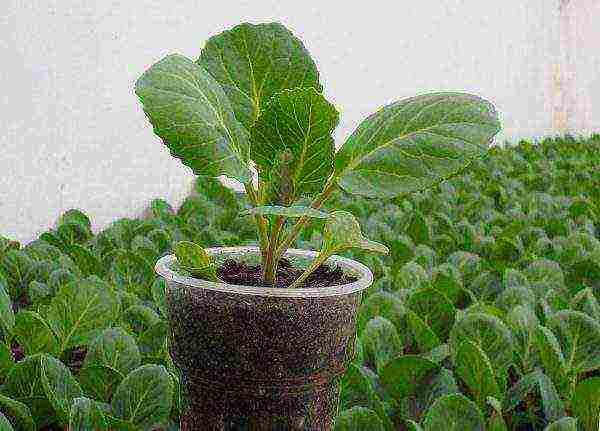
You can take pots and 6 cm in diameter
Picking
After the appearance of the first true leaf, the seedlings are planted if they were planted in a common box. Before transplanting, you need to water the seedlings well so that it is easier to get the plants out of the ground. Also, the roots are pinched to 1/3 of the seedlings. After that, you can water the plants with a weak solution of potassium permanganate. Within three days after transplanting, the temperature for the seedlings should be 17-18 C, after which it must be lowered to 13-14 C during the day and 10-12 C at night.
Features of seedling care
Watering of seedlings at all stages of development is carried out as the soil dries up. A couple of weeks before planting the plants in a permanent place, you need to start hardening them. To do this, they are taken out onto a glazed loggia or placed on a half-open window. At first, for an hour or two, then the duration of the procedures is increased up to a whole day. Drafts should be avoided.
It is advisable to carry out the following dressings:
- When the first pair of true leaves has developed, root feeding of the seedling is carried out with a solution of complex fertilizer (1 teaspoon for 2 liters of water). The liquid should be watered the plant, as with ordinary water, do not overdo it.
- The second, foliar feeding, is carried out during the hardening of the seedlings. To prepare the solution, dissolve in 10 liters of water in a tablespoon of urea and potassium sulfate. Spray the seedlings at the rate of 1 cup of the mixture per plant.
Disembarkation to a permanent place
It is better to choose a place for the beds of Savoy cabbage in the south or southeast, as it loves warmth and bright lighting. Acidic soils are not suitable for it, neutral ones are preferable. The culture grows best of all on loam and sandy loam, but its cultivation on sandy and clay soils will cause difficulties. The earth is prepared in the fall, digging up the soil and lime it if necessary. In the spring, the site is fertilized with rotten manure or compost (3-4 kg per 1 sq. M.) And wood ash (100-200 g per 1 sq. M.). Ash can be replaced with a complex mineral fertilizer (30–40 g per 1 sq. M.). After the spring introduction of nutrients, the earth is also dug up.

All varieties of cabbage, as well as other plants of the Cabbage family (Cruciferous) are not suitable as predecessors or neighbors for the Savoyard
Seedlings are planted after 2-3 pairs of true leaves appear. The planting scheme depends on the ripening period; for early-ripening varieties 40X40 cm, mid-ripening - 50X50 cm, late-ripening - 60X60 cm.
- 2 hours before planting, the plants are well watered.
- The seedlings are deepened to the first leaf.
- After planting, the plants are also watered.
- The first few days the cabbage is shaded from direct sunlight.
- If there is a threat of frost at night, the plants should be covered with foil.
It is best to plant Savoy cabbage after potatoes, legumes, onions, beets, tomatoes and cucumbers. But after the plants of the Cruciferous family, at least 3 years should pass.
Video: planting savoy cabbage for seedlings
Growing features
Care includes the standard activities for any cabbage:
- Watering. Plants should be watered for the first time after transplanting to a permanent place at intervals of every two to three days at the rate of 8 liters of water per 1 sq. Later, watering is carried out once a week at the rate of 13 liters of water per 1 sq.m. However, this is an approximate schedule, first of all, you need to focus on the weather and soil condition. In rainy weather, watering is carried out less often, in heat more often: the soil should not dry out. Most of all, water is needed in May for early varieties and in July-August for late ones.

The main activities for the care of Savoy cabbage are loosening, watering and weeding
- Loosening. The first time the soil is loosened immediately after planting young plants to a permanent place, to a depth of 5–7 cm. Further, loosening is carried out once a week, to a depth of 12–15 cm; the heavier and wetter the soil, the deeper it should be loosened.
- Hilling. It is produced a month after planting, or a little earlier. Late-ripening varieties are hilled again by closing the rows, approximately one and a half weeks after the first hilling.
- Weeding. Weeds should be removed from the beds as needed.
- Prevention of pests and diseases. As a preventive treatment, if you do not want to use chemistry, the plants are pollinated with wood ash (1 glass per 1 sq. M.), And watering the earth with a solution of potassium permanganate is effective against fungus. You also need to inspect the leaves, especially from the underside, in order to notice insects and their eggs in time.
For normal growth and development, the plant needs nutrients, therefore, fertilizing is carried out twice a season:
- When the seedlings planted in a permanent place begin to grow, you need to feed it:
- solution of cow dung in water (in a ratio of 1:10)
- or a complex mineral fertilizer (15 g of urea, 15 g of potassium sulfate, 40 g of superphosphate per 10 liters of water).
- The second feeding is done with mineral fertilizer, when the leaves of the cabbage begin to curl. For her, the dosage of superphosphate and potassium is increased by 1.5 times.
Cleaning and storage
Early ripening varieties are harvested when the heads of cabbage become firm. The timing of harvesting late-ripening varieties is chosen depending on whether long-term storage is expected. For winter storage, heads of cabbage must be harvested at a temperature of at least -3 C.
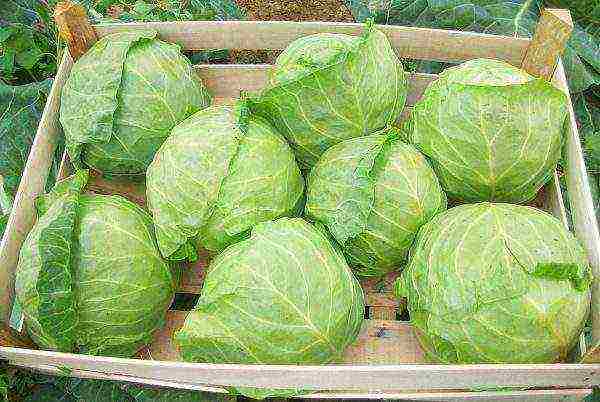
The best way to store cabbage is to put it in wooden boxes, but the heads of cabbage should not touch each other.
It is worth remembering that Savoy cabbage leaves are edible too.
In order for cabbage storage to be successful, you need to follow some rules:
- It is undesirable to water the plant before cutting the heads.
- It is better to cut cabbage in dry weather.
- It is necessary to leave 2-3 sheets of covering leaves on the head of cabbage, which will protect it from external influences.
- Heads of cabbage must weigh at least a pound; the larger the head of cabbage, the better it is stored.
- Only healthy heads of cabbage are suitable for long-term storage:
- which are not frostbitten;
- do not have rotten areas;
- not infested with pests or fungal diseases.
Before you put the cabbage for storage, you need to dry it: sprinkle the heads of cabbage with chalk crumbs and spread them for two or three days in a dry room on shelves, preferably trellised ones. You also need to shorten their stumps to two or three centimeters.
Theoretically, you can store Savoy cabbage for up to six months, but many gardeners talk about two to three months' storage at best. Creation of the right conditions plays an important role:
- The heads of cabbage should be stored in wooden boxes, leaving a distance of several centimeters between them.
- The cabbage is stored in the position of the cut stump upwards.
- Storage temperature from 0 to 3 C.
- Air humidity 90–95%
- The storage room should be free of fungus, mold and rodents; it is advisable to treat the basement or cellar with an antiseptic.
You can store Savoy cabbage not only in boxes:
- It is allowed to store heads of cabbage in a grid suspended from the ceiling, while they must be placed separately, with a gap of several centimeters between the grids.
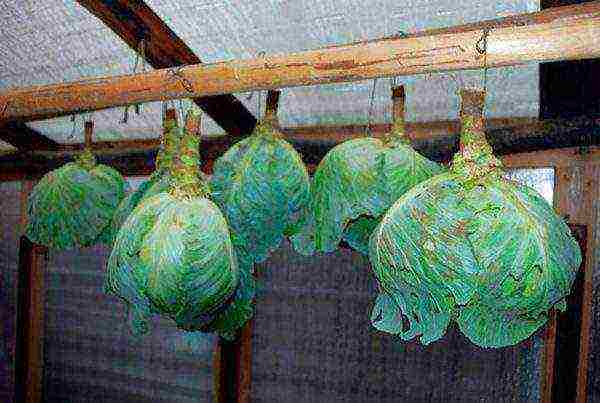
Some keep cabbage hanging not in nets, but by stumps
- You can make a pyramid from heads of cabbage and sand. The largest specimens should be placed at its base, which are placed with stumps up. A layer of cabbage must be completely covered with sand, and the next layer is to lay smaller heads of cabbage (they must be placed with stumps down), which are again covered with sand. According to this principle, heads of cabbage are placed to the very top of the pyramid.You can also cover the heads of cabbage with sand in the box.
- Heads of cabbage can be wrapped in cling film or a thick layer of paper.
Video: Savoy cabbage is a worthy competitor to white cabbage
Reviews
Savoy cabbage care is not difficult, and its nutritional value is very high. Try to grow this uncommon culture on your site and, perhaps, it will become your favorite.
Rate the article:
(0 votes, average: 0 out of 5)
Savoy cabbage is rarely found in Russian regions, although it is even more useful than white cabbage: it contains many vitamins and trace elements, is low in calories and is simply beautiful. But its yield is low in comparison with traditional cabbage, which, apparently, is the reason for its low popularity. At the same time, Savoy cabbage is even easier to care for and can be easily grown both in large farms and in a backyard or country garden.
Savoy cabbage varieties
Savoy cabbage was first grown in Italy, and it got its name from the County of Savoy. Cabbage moved to Eastern Europe at the end of the 18th century, and in our country it is still rarely grown, although there are all the conditions for this. Savoy cabbage tastes very similar to white cabbage. It also forms heads of cabbage, but looser and surrounded by large corrugated leaves, most often green. There are no coarse veins in this cabbage. The leaves are great for making stuffed cabbage, and in general, its use in cooking is similar to white cabbage, but the Russian person may be limited by the fact that Savoy cabbage is unsuitable for pickling.
Video: Savoy cabbage cabbage rolls
More recently, there were not very many varieties of Savoy cabbage, but in recent decades the situation has changed, now there are many varieties and hybrids of different ripening periods. Depending on the timing, varieties are divided into the following groups:
- early maturing - 3.5-4 months;
- mid-season - 4–4.5 months;
- late ripening - more than 4.5 months.
As you can see, the difference in timing is not fundamental, and since Savoy cabbage is extremely cold-resistant, varieties of different ripening periods are equally popular.
Early varieties
- Early Vienna seems to be the best variety for many gardeners, although, of course, in taste and color ... The leaves are strongly corrugated, have a slight bluish bloom. Rounded dark green heads of cabbage grow to a weight of 1 kg. Suitable for making a wide variety of dishes.
- Culinary experts prefer another early variety - Zolotaya Early, and it is he who is considered the best. This cabbage ripens earlier than most others, with a growing season of just over 3 months. Heads of cabbage are a little less than a kilogram, but they are stored for a long time, and in the garden, even in very wet weather, they do not crack. Suitable not only for culinary processing, but also for preparing salads, where it is put fresh.
- It takes a little longer for the heads of cabbage of the Petrovna variety to ripen. Heads of cabbage grow a little more than a kilogram in weight, the color is deceiving: outside it is dark green, like most varieties of Savoy cabbage, but inside the head of cabbage it is light yellow. High-yielding variety. It is used in different forms: both without heat treatment and for preparing first and second courses.
- The earliest ripening variety is the Moscow lacemaker: the harvest can be ready exactly 3 months after sowing the seeds. It is considered an ideal cabbage for cabbage rolls. Flattened heads of cabbage grow weighing up to one and a half kilograms, slightly yellowish inside, the leaves are very delicate, strongly bubbly. Productivity up to 4.5 kg / m2, universal application.
Photo Gallery: Early Savoy Cabbage
Mid-season varieties
- One of the most popular medium-ripening varieties is a hybrid - Melissa F1.It is characterized by a high stable yield, since the average weight of a head of cabbage is 3 kg, and some specimens grow up to 4 kg. At the root, heads of cabbage do not crack, have a flattened shape, dense. The leaves are dark green in color, but do not shine; due to the wax coating, they appear dull, strongly wrinkled, contain many air bubbles. The variety is resistant to diseases and adverse weather conditions. Cooking applications are universal.
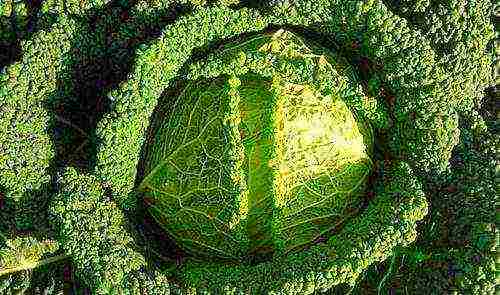
Melissa is considered one of the most successful hybrids.
- The Sfera variety gives a medium-sized head of cabbage, up to 2.5 kg, yellow inside. The leaves are dark green, large. Gourmets note the sweetish taste of products made from this cabbage variety.
Late varieties
- The Uralochka variety grows into a medium-sized round head of cabbage, a little over two kilograms, its inside is dense, yellowish. The leaves are large, light green in color, the corrugation of the leaves is very strong, there are no veins. The heads of cabbage do not crack, they are characterized by a very good taste, especially when fresh.
- About the same heads of cabbage in the high-yielding variety Alaska, they are covered with not very large gray-green leaves with a significant waxy bloom. The leaves are wavy. Products of this variety are well stored, can be used for any processing, fresh is used less often.
- Heads of Savoy cabbage of the Nadya variety grow up to 3 kg. They are transportable, but do not last long. They do not crack or get sick on the garden bed, the heads of cabbage are covered with delicate bubbly leaves.
- Unlike the early variety Moskovskaya Kruzhevnitsa, the late Kruzhevnitsa variety is characterized by reddish heads of cabbage. They are medium in size, no more than 2 kg, keeping quality is also low, but the taste is very good. The leaves are bubbly, but thin.
Photo Gallery: Late Savoy Cabbage
Savoy cabbage growing
Savoy cabbage is a subspecies of white cabbage, so its agricultural technology is not much different from that of the "older sister". Savoy cabbage is much inferior in yield, but it compares favorably with its taste and high content of useful components. It is the most cold-resistant of all known varieties of cabbage: many late varieties do not die even at -10 ° C. It is also more drought-resistant than all its other relatives.
Savoy cabbage is undemanding to the composition of the soil, although, of course, it grows better on cultivated fertile ones. Late varieties require more nutrition than middle and early varieties. Of all types of fertilizers, he prefers organic. The best soils for it are loams with a neutral reaction of the environment: strongly acidic soil must be limed beforehand. It grows well on peat bogs, but not very swampy. Shading does not tolerate well.
The best predecessors are potatoes, cucumbers, legumes, the bad ones are cabbage, radish, beets, tomatoes. As with any garden crop, it is better to prepare the garden in the fall, but Savoy cabbage does not need very loose soil, so the main autumn concerns are to add fertilizer to the garden. Up to 2 buckets of manure or compost can be used for each square meter, and half-rotted manure is also suitable. You can take a lot of ash, up to 2 liters per square meter. Superphosphate (40-50 g) does not hurt, but it is also optional.
Features of planting through seedlings
Almost always, Savoy cabbage is grown through seedlings, but no one bothers to sow seeds directly into open ground, especially in the case of early varieties. If you do this in early spring, as soon as the soil allows you to work, then the harvest over the summer will have time to ripen. The seedling method is more common, but growing seedlings of any cabbage in a city apartment is not easy, because it is always too hot there in the spring. But an unheated greenhouse is the best option for this.
You can start sowing seeds of early varieties for seedlings already in March. There will be nothing unusual in growing Savoy cabbage seedlings for an experienced gardener, the procedure is familiar:
- Seed preparation, including disinfection (15–20 minutes in hot water, about 50 ° C), soaking in a solution of trace elements (optional) and hardening (in the refrigerator for 24 hours).
- Preparation of planting tanks. Better - separate cups, ideally - peat, but you can sow in a common box. Any soil will do, cabbage is undemanding, but sod land with peat is better.
- Sowing seeds. The seeds do not differ in size from the seeds of most cruciferous crops, they are not very expensive, so you can put 2-3 seeds in each pot, then remove the extra shoots. Sowing depth - 1–1.5 cm. After sowing, water it well (preferably with a pink solution of potassium permanganate) and wait a few days. You can sow thickly in a common box, since then almost all gardeners still dive seedlings in separate cups.
- Rapid and sharp drop in air temperature immediately after germination. For the first 5–7 days, they should be kept at a temperature no higher than 8 ° C, which is the most difficult at home. In this case, the illumination of the seedlings should be as high as possible.
- Growing seedlings at a temperature not higher than 15 ° C (this is during the day, and even lower at night), including moderate watering and rare top dressing. Watering is desirable in the morning, to exclude stagnation of water. Top dressing (2 times for the entire time) - complex mineral fertilizers.
- Picking (if necessary and at will).
- Hardening before planting in open ground (a week before the intended sending to the garden, they are taught to low positive temperatures).
- Actually transplant to the garden (in the morning before transplanting, the seedlings are watered abundantly).
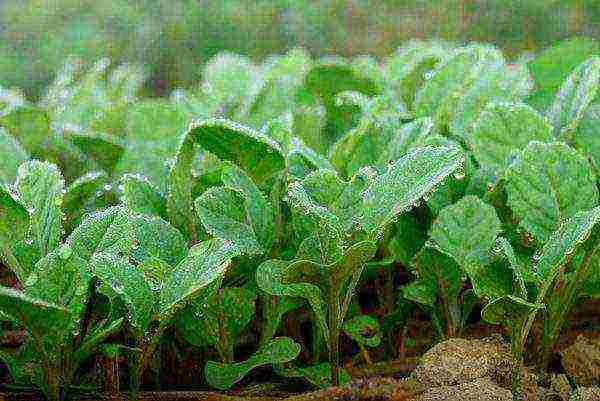
Savoy cabbage seedlings outwardly differ little from ordinary cabbage seedlings
How to dive cabbage
Is it necessary to dive Savoy cabbage seedlings? If it was immediately sown in separate cups or peat pots, then it will grow well without picking. If this is a common box, you can thin out and, subject to the temperature regime, grow good seedlings, and then plant them in a garden bed, carefully removing them with an earthen lump. But the strongest seedlings grow after the pick, because in this case, the tip of the root is usually pinched, and the root system grows more powerful.
The pick should be carried out 10-14 days after the emergence of shoots, when they have only cotyledonous leaves and at most one real one. Before picking, the seedlings must be well watered so that it is easier to remove the seedlings from the ground. Usually at this age they have only one central root, it must be shortened by about a third. The seedlings are planted in a new place (in separate containers), deepening to the very cotyledonous leaves.
Immediately after picking, the soil in the pots should be watered with a pink solution of potassium permanganate, after which it is necessary to create twilight for the plants for several days and raise the temperature to 18 ° C. As soon as it becomes clear that the seedlings have taken root, the temperature must be lowered again, and the illumination must be added.
Planting cabbage in open ground
In open ground, seedlings are planted with 5-6 leaves. Early varieties can be planted throughout May according to the scheme 35 x 40 cm, the rest of the varieties are planted a little later, the gaps between the plants are left up to 60 cm in size.
Despite the fact that fertilizers were buried in the garden in advance, local application during planting significantly increases the future yield. Before planting, you can pour 2 tablespoons of superphosphate, 1 teaspoon of urea and 2 cups of wood ash into each hole dug with a scoop, then mix well and pour with water.
The seedlings are buried a little, but so that the real leaves are not buried in the ground. For the first few days of planting, it is advisable to shade, using at least bunches of plucked grass for this. If the seedlings are planted early, in April, they should be covered with non-woven fabric or paper caps to protect them from possible frost.As a preventive measure, to protect against cruciferous flea beetles, it is recommended to sprinkle the soil around the plants with wood ash.
Plant care
The main operations when caring for Savoy cabbage are the same as for any other: watering, feeding, loosening. Despite the fact that this crop is drought tolerant, this does not mean that it does not need to be watered. On the contrary, it requires a lot of water, and drought resistance only means that during a forced interruption in irrigation, it does not die, it tolerates it, but does not develop. The moisture evaporates intensively through the large wavy leaves. The first two weeks of watering are required every other day, then they should become weekly. The soil should be moist enough without stagnant water. After watering, loosening is required to a depth of 8 cm, until the leaves of neighboring plants close. The denser the soil, the deeper it needs to be loosened.
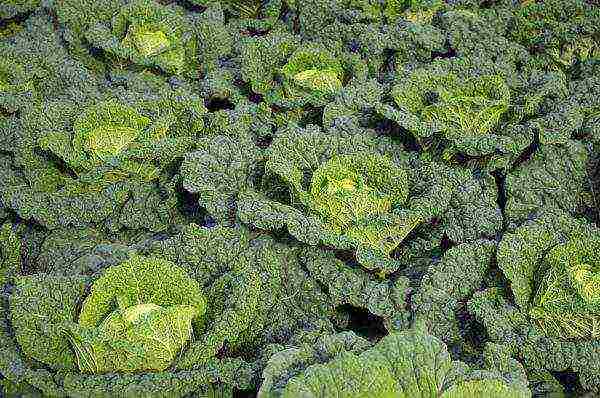
Very soon, loosening and hilling will be impossible, and the leaves will have their own microclimate.
After 2-3 weeks, it is advisable to start hilling cabbage and do it while there is access to the roots. After the first hilling, the cabbage can be fed with mullein infusion (1: 10). The second feeding is necessary at the moment of the beginning of the setting of the heads of cabbage. If there is no mullein, you can also use mineral fertilizers, most conveniently - complex fertilizers (nitrophoska or azofoska), strictly according to the instructions on the package. Each plant requires about a liter of nutrient solution, which it is desirable to make into shallow grooves, and then cover them with earth.
Savoy cabbage is rarely infested with pests. As a preventive measure against the cruciferous flea, dusting the plants with wood ash is used.
Savoy cabbage is very hardy. This is especially true of late varieties, which are often left for the winter in the garden, where it is under the snow. Heads of cabbage are cut when required. And with regard to earlier varieties with harvesting, you should not be late: some varieties crack strongly after reaching full maturity. At a temperature of 1-3 ° C, the heads of most late varieties can be stored for about three months, among the early ones, only a few are well stored.
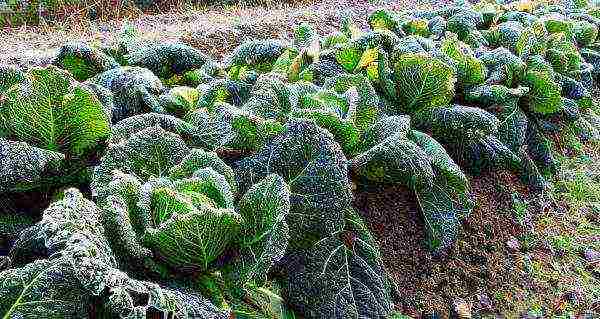
Late varieties feel great in the garden even when the grass around is already withered and frozen
Features of growing savoy cabbage in the regions
Savoy cabbage can be grown almost throughout the entire territory of our country: it doesn't care about the cold, it would be wet and not too hot. Therefore, it turns out that certain difficulties exist only in the most southern regions.
Middle zone of Russia
It would seem that a native of sunny Italy should not be very comfortable in the middle zone of our country. However, this is not so: the climate of the Non-Chernozem and Chernozem regions is perfect for growing this undemanding vegetable. Savoy cabbage seeds germinate at temperatures above 3 degrees, and adult plants can withstand frosts on the ground down to -10 ° C. Moreover, low temperatures have a beneficial effect on the taste of the product.
Nevertheless, in summer cottages and backyards in Russia, this cabbage is very rare, although its chemical composition is twice as wide as that of white cabbage, and the leaves are much more delicate and beautiful.
Those gardeners who once tried to plant Savoy cabbage, as a rule, continue to do this annually.
In the middle lane, cabbage is traditionally grown through seedlings, but those lovers who have a greenhouse sow seeds for seedlings in it: it is easier there to keep the temperature not too high in the spring. It is surprising that direct sowing of seeds in a garden bed has not found wide application: even in the middle lane it is quite possible, and there is much less hassle. The seeds can be sown immediately into the holes, where the cabbage will spend its entire life. This should be done, depending on the weather, from mid-April to mid-May.
Moscow region
The Moscow region, of course, belongs to the middle zone, but farmers often distinguish it due to the instability of the weather. Although this does not apply to the cultivation of Savoy cabbage, everything is done here in the same way as, for example, in the conditions of the Bryansk or Nizhny Novgorod regions. Savoy cabbage grows remarkably well in the Moscow region. One of the most suitable varieties is Zolotaya early.
Gardeners near Moscow do not always grow seedlings at home, and if they do, they sow seeds in April, and at the end of spring they transplant seedlings to the garden bed. Many people try to sow cabbage directly into open ground, but still not in a permanent place. For seedlings, a small bed is equipped, where seeds are sown at the end of April under spunbond or other non-woven material. Often in May there is such a weather that the seedlings do not even need watering, and at the end of the month they are transplanted into prepared holes. They are fed with ash and infusions of weeds, which are always full in the gardens.
Video: Savoy cabbage harvest in the garden
Ural
Even apricots and watermelons are now grown in the Urals, so there are no problems with cabbage. Here, as in Siberia, Savoy cabbage of the early ripening variety Yubileinaya is often planted.
Unlike warmer regions, mineral fertilizers are mainly used in the Urals. Well, of course, they are produced here. But that’s not the main thing. The specifics of the harsh Urals and its short summer make it necessary to plant only early varieties of Savoy cabbage, which grow quickly, and the decomposition of organic fertilizers does not keep pace with the growth of green mass. Mineral fertilizers are more accessible to the roots, they are "first aid" for rapidly developing plants.
Reviews
Savoy cabbage in our country is just beginning its journey, slowly gaining popularity. Growing it is very simple, but requires some effort, and yields are much lower than that of white-headed varieties. However, there is a lot of cultivated areas in our country, and the desire to save space should not limit the spread of an unusual, but very useful vegetable across the territory of Russia.
Graduated from the Chemistry Department of Moscow State University in 1981. Candidate of Chemical Sciences, Associate Professor. Rate the article:
(1 vote, average: 5 out of 5)
This cabbage was grown several centuries ago in the Italian county of Savoie. It came to us at the end of the 18th century, but until now summer residents rarely grow it in their gardens, preferring the usual white cabbage. Nevertheless, according to scientists, savoy cabbage has a complex of vitamins that is twice as rich as white cabbage. It is distinguished by great endurance, frost resistance. Some varieties of Savoy cabbage, under certain conditions, can continue their growing season in winter, and in May they are already harvesting.
Features of savoy cabbage
Outwardly, Savoy cabbage is very similar to white cabbage. Unless, due to the corrugated texture of the leaves, its head is looser to the touch and its color is more intense green.
Some gardeners take it for a white cabbage hybrid, but this is not the case. Savoy cabbage is a separate subspecies of white cabbage, which has its own specifics of cultivation, care, etc. But nevertheless, it differs little from the features of the construction of a vegetable that is more familiar to us.
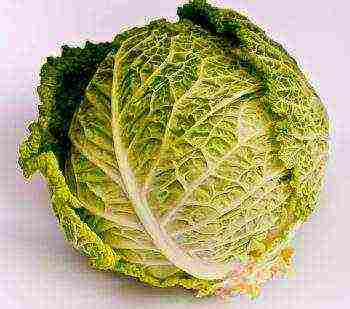
What does a savoy cabbage look like close-up
This culture stands out for its cold and drought resistance, it is less affected by diseases and pests than others. She can tolerate heavy soils, peat bogs normally. She likes floodplain areas. In the land, which is determined for planting Savoy cabbage, it is recommended to apply fertilizers, especially organic (8-10 kg / sq. M) and increased doses of phosphorus - on heavy loams, potash - on floodplains.
Savoy cabbage properties:
- Due to the fact that savoy cabbage is easily absorbed by the body, it is recommended for dietary nutrition, diabetes, as well as for children and elderly people.
- It is used in the preparation of the same dishes as white cabbage. You can't just ferment it.
- This vegetable is rich in proteins, carbohydrates, organic acids, fiber, vitamins C, B1, B2, K, E, provitamin A, and mineral salts. Especially potassium.
- Savoy cabbage, in comparison with other types of this vegetable, contains the most sinigrin - a substance that has anti-cancer and antibacterial properties.
- It tastes more tender and pleasant than white cabbage.
- Low yield. Stored for no more than 2 months.
- Savoy cabbage can be left in the garden in the winter under the snow. And in January-February, clean up the snow, cut down the cabbages, put them in cold water for a few minutes and use them.
- It is the most frost-resistant of all other types of cabbage (it can withstand temperatures down to -8 ° C).
Savoy cabbage cultivation
The technology for growing seedlings of this culture is in many ways similar to growing white cabbage. Early ripening varieties are sown in mid-March, mid-ripening and late-in mid-April. Seedlings are planted with a row spacing of 40-50 centimeters. At the same time, in a row, the distance between plants for early-ripening varieties is 30 centimeters, for late-ripening ones - 40 centimeters.
After the seedlings have hatched, the temperature is reduced to 8-10 ° C. When cotyledons or one or two leaves appear, the beds are watered to facilitate the selection of seedlings.
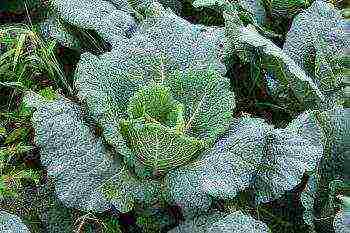
Savoy cabbage is one of the most popular vegetables
It is better to water the seedlings in sunny weather in the morning, and then air them. It is advisable to dive seedlings into nutritious pots or cubes. During the day, in sunny weather, the seedlings should be shaded for 2-3 days with a newspaper dipped in water. Savoy cabbage seedlings will be ready for planting when 4-5 true leaves appear in about 40-45 days.
To plant early varieties of Savoy cabbage, which are more early ripening, you should choose sunny, sheltered from the wind areas. It is good if legumes, potatoes, tomatoes, cucumbers, beets, onions grew on them before.
Savoy cabbage needs many nutrients in a readily available form. Therefore, the soil for planting must be prepared in the fall. First of all, it must be loosened to a depth of 8-10 centimeters, and when the weeds sprout - after about two weeks - add 5-7 kilograms per square meter to it. m of organic fertilizers and dig up on a full bayonet of a shovel.
In early spring, the area should be disassembled so that moisture remains in the soil. On the eve of planting seedlings, the site must be dug to a depth of 12-14 centimeters.
When planted very early in open ground, early varieties of Savoy cabbage are covered with a transparent film, since under prolonged exposure to low temperatures, plants can begin to shoot. These varieties can be planted until the end of May at several times. Mid-season and late varieties should be planted in late June - early July.
When planting, the distance between plants in early varieties is 35-40 centimeters, between rows - 40-15 centimeters. Planting scheme for mid-ripening varieties - 50x50, late-ripening - 60x60 centimeters. After 5-6 days, replanting new ones should be carried out in place of the dead plants.
Savoy cabbage care
This culture requires careful maintenance. It needs to be regularly loosened, fed and hilled.
The first loosening and weeding, especially on heavy soils, is very important to carry out on time - immediately after planting to a depth of 5-7 centimeters, while simultaneously removing weeds. The depth of subsequent loosening should be increased to 12-15 centimeters. If the cabbage is planted on dry and light soils, loosen it more finely, on heavy and wet soils - deeper. Around the plants, it is necessary to loosen very finely so as not to damage the rhizomes.
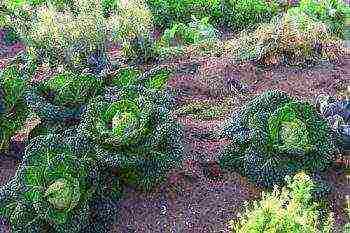
Correctly planted cabbage in the garden
When to feed Savoy cabbage
- The first feeding of plants is carried out when they grow. It consists of a mullein solution (1:10) or a mixture of mineral fertilizers (for 10 liters of water - 15 grams of urea, 40 grams of superphosphate, 15 grams of potassium fertilizers).
- The second is done during the period of curling the head of cabbage: increase the amount of potash and phosphorus fertilizers by 1.5 times.
It is necessary to spud all varieties of Savoy cabbage 3-4 weeks after planting.Before closing the rows, the late varieties must be hilled a second time.
Early varieties most often need to be watered in May; late - from mid-July to mid-August.
Savoy cabbage harvesting and storage
Early ripe varieties of Savoy cabbage must be harvested selectively, starting at the end of June. You shouldn't be late with harvesting, because the heads of cabbage can crack. To avoid this, you can trim the bottom leaves or carefully trim the roots.
You should not rush to collect late-ripening varieties, since they are not afraid of frosts. When cutting off heads of cabbage, leave 3-4 outer leaves on them, which will protect the inner leaves from breaking off. Mature heads of late varieties can be left in the garden for the winter under the snow. And cut them off as needed.
Savoy cabbage is nowhere near as well stored as white cabbage. Therefore, it only needs to be stored in one row in boxes or on shelves. To extend the shelf life, the storage temperature must be lowered to -1-3 ° C frost.
Savoy cabbage varieties
| Varieties | Ripening period | Description |
| Early ripe | Up to 120 days | 1. "Jubilee". Head of cabbage weight up to 0.8 kg, prone to cracking.
2. "Gold early". Heads of cabbage are round. Weight up to 1 kg. Resistant to cracking. High-yielding. 3. "Julius F1". Head of cabbage weight 1.5-3 kg. |
| Mid-season | 120-135 days | 1. "Melissa F1", a fruitful hybrid. Resistant to cracking Heads weight up to 3 kg.
2. "Sphere". Heads of cabbage do not crack. Weight up to 2.5 kg. |
| Late | More than 140 days | 1. "Ovassa F1" is a hybrid of Dutch selection. Harvested. Unpretentious. Head of cabbage weight up to 2 kg.
2. "I am turning 1340". Harvestable. Heads of cabbage weigh up to 3 kg. 3. "Verosa F1". Hybrid. Heads of cabbage weigh up to 3 kg. 4. "Morama F1" Hybrid. Heads of cabbage weigh up to 4 kg. |
Other popular Savoy cabbage varieties:
- 1. "Nyusha". An early ripe variety intended for personal subsidiary plots. It has a rounded head of cabbage, partially covered with leaves. Medium density. Heads of cabbage weigh up to 1.4 kilograms. The leaves are gray-green. Used in home cooking. It is not stored for long.
- "Thaler". Hybrid. Medium early. Has a flat, large head of cabbage. Weight up to 2 kilograms. Productivity 40-50 t / ha. It is not stored for long.
- "Tasmania". Medium early hybrid. It is not stored for long. Frost resistant. It grows well on soils with a low nitrogen content. A rounded head of cabbage weighs up to 1.5 kilograms.
- "Uralochka". Late variety. Salting and other types of culinary processing are possible. A round, dense head of cabbage weighs up to 2.2 kilograms.
- "Extrema F1". Mid-season hybrid. Resistant to fusarium wilt. The leaves are distinguished by their exceptional taste. It is not stored for long. Productivity 5.4-8 kg / sq. m.
Savoy cabbage diseases
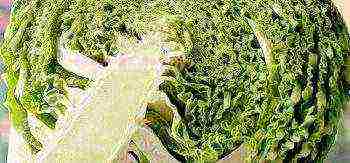
What does a savoy cabbage fruit look like in a cut
Alternaria - fungal disease. Signs: small brown necrotic spots appear on cabbage leaves.
Bel. Signs: cabbage with this disease looks like it is painted with white oil paint. Eventually, the plant turns brown and dries up.
Keela. Spherical and fusiform growths appear on the roots of cabbage. The roots turn brown and rot over time.
Downy mildew... Yellowish spots appear on cabbage leaves. Their inner side is covered with a white bloom. The lower leaves turn reddish yellow.
Mosaic. The veins of young leaves are bent, they are strongly contracted, and deformed. Later, a dark green border appears on the leaves. Light necrotic spots appear on the tissue between the veins.
Other diseases that can affect savoy cabbage: phomosis, vascular bacteriosis, fusarium wilt or tracheomycosis, black leg, black ring spot.
Disease control methods
In order to avoid diseases of Savoy cabbage, it is imperative to process the seed; strictly observe the rules of agricultural technology; fight weeds; after harvesting to destroy plant residues; systematically dig up the beds; Change the Savoy cabbage planting site every year.
If, nevertheless, the disease has struck your plants, you need to know: it is impossible to cure black spot and mosaic. Therefore, the sooner, the better, the heads of cabbage affected by the disease should be removed and burned, and the soil in which they grew should be watered with a strong solution of potassium permanganate.
Treat savoy cabbage with fungicides for fungal diseases. These are Fundazol, Fitosporin, Bordeaux mixture, copper sulfate, colloidal sulfur, etc.
Savoy cabbage is used in many different culinary dishes
Savoy cabbage pest control
Cruciferous flea. Gnaws small holes in cabbage leaves. At an early stage, you can fight the flea: cover the plants with non-woven material. Cabbage and the soil around the beds should be powdered with wood ash and tobacco dust in a 2: 1 ratio, after sprinkling them with water. Plant celery between the rows of cabbage, which the flea bean hates. In emergency cases, the beds should be treated with Actellik.
Spring cabbage fly. This insect lays eggs in the soil around the stems. And its larvae then eat up the roots and stems of the cabbage. Treat cabbage beds with preparations "Ambush", "Corsair", "Rovikurt".
Whitefish and scoops... The most dangerous are caterpillars that damage cabbage leaves. To avoid their invasion, it is advisable to plant the cabbage before the butterflies begin to fly out. Treat the beds with Ambush, Belofos, Rovikurt, Anometrin, Cyanox, Gomelin, Bitoxibacillin, etc.
Rapeseed and cabbage bugs... When the Savoy cabbage is damaged by bedbugs, its leaves turn yellow. Treat the beds with Actellika solution.
Aphid. It feeds on the juice of cabbage leaves, which lose color and curl. This small sucking insect spreads incurable viral diseases among plants. As a preventive measure, plant celery, dill, carrots between the beds of Savoy cabbage, to which hoverflies and ladybugs will reach, which exterminate aphids. Water and weed your beds regularly. Treat the beds with preparations "Ambush", "Rovikurt", "Biotlin", "Corsair".
In addition to all the listed pests, savoy cabbage can be affected by the cabbage root lurker, wireworm, bear, slugs.
In the fight against these pests, first of all, it is necessary to take preventive measures. And this: observance of crop rotation and agricultural technology; planting Savoy cabbage in open ground as early as possible; regular weed control; in autumn, cleaning and burning of all plant residues and deep digging of the site.
Question answer
- What are the benefits and harms of savoy cabbage?
Savoy cabbage has a very rich composition of nutrients. For example, it contains alcohol beckons, which is used as a sugar substitute. Therefore, this vegetable is recommended for diabetics. Savoy cabbage is also used as a prophylactic agent against cancer, because it contains chlorophyll, which prevents DNA molecules from changing in cells. Therefore, the risk of cell transition to malignant is reduced.
Savoy cabbage can be harmful to people who have recently had chest or abdominal surgery. It is contraindicated for people suffering from acute gastritis and enterocolitis, with exacerbation of ulcers, with increased acidity.
- I kept the cabbage wrapped in newspaper on the balcony. When unfolded, it turned out that it had become slimy and smelly. Can you still save her?
Such cabbage can no longer be eaten. She developed a slimy bacteriosis. This disease is transmitted through plant debris and seeds. In order not to carry the infection with seeds, they must be kept in water heated to + 53 ° C for 15-20 minutes before sowing. Then sow immediately.
Rate the quality of the article. We want to be better for you:
Savoy cabbage was bred in the Italian city of Savoy, where the name comes from.It was brought to Eastern Europe only in the 19th century, but it did not receive wide distribution in comparison with white cabbage. Although experts note the tenderness of its leaves, and a pleasant, more refined taste. How to properly grow Savoy cabbage outdoors, care and water, as well as the best varieties will be described below.
Features of savoy cabbage
Savoy cabbage is in many ways similar to white cabbage, but it also has distinctive qualities. The heads are beautiful, round, usually even, without abnormal curvatures, not elongated. The leaves are corrugated, strongly curly and thin. Cabbage is grown outdoors, it is not demanding to care for and feels good in the southern and eastern regions.
In terms of taste, it is similar to white cabbage, but more delicate, pleasant to the taste. Thick and hard veins are completely absent, so there is no need to cook it for a long time, it softens quickly. Not hard, but crunches in fresh vegetable salads. The aroma is delicate and pleasant.
Savoy cabbage is much more nutritious than its white or red sister. A large amount of biologically active substances, a lowered rate of fiber and an abundance of healthy fats makes it really useful.
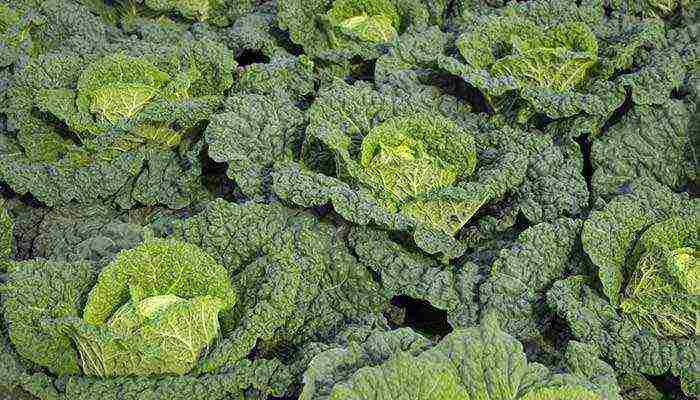
Photo of savoy cabbage
What are the benefits of savoy cabbage?
Not all types of cabbage are healthy if eaten frequently, but Savoyard is an exception. It is even often prescribed by doctors for the treatment of various ailments.
- It contains an abundance of vitamins A, B1, B2, B6, C, E, PP, minerals such as phosphorus, potassium, magnesium, sodium, calcium, iron. Also available: sugar, fiber, mustard oils, proteins, carbohydrates, ash substances, thiamine, riboflavin, phytoncides, amino acids, pectins.
- Thanks to glutathione, savoy cabbage can increase skin elasticity, prevent aging, improve the immune system, and participate in the restoration of the nervous system.
- Ascorbigen was first discovered in its composition in 1957. This substance is able to block the development of cancerous tumors and prevent them from growing.
- It is much more nutritious and softer than white cabbage, so it is easier and more pleasant to eat.
- Can be used by people with diabetes mellitus and those with high blood pressure.
- Due to the fact that it is quickly absorbed, it is prescribed instead of white cabbage for children, the elderly, as well as the postoperative and recovery period after mild and serious illnesses.
- It removes excess water from the body, increases appetite.
In 100 g of the product there are only 28 kcal, and in boiled cabbage - 24 kcal. For this reason, this variety is recommended for people on diets who want to lose weight.
Savoy cabbage harm and contraindications
And although Savoy cabbage has a lot of useful qualities, not everyone can eat it. Because of the fiber in the composition, it can harm people with exacerbation of gastritis, ulcers, pancreatitis, thyroid diseases, and those who have had surgery on the intestines or stomach.
However, during the recession of the disease, it is better for a patient who still uses cabbage to give preference to the Savoyard rather than the white-cabbage variety, since there is 25% less fiber in it, and therefore it does less harm.
Children under 7 months should not eat cabbage. It is also not recommended for people with individual intolerance to the product, although such cases are extremely rare.
Our readers recommend articles: the best varieties of broccoli cabbage, how to properly plant cabbage for seedlings, the better to feed cabbage seedlings.
The best varieties of Savoy cabbage
Savoy cabbage has many varieties and varieties that differ in ripening time, cultivation characteristics and some other parameters.
- Melissa F1 - mid-season variety. Twisted sheets, medium corrugation, dark green color. Round-flat heads, weighing up to 3 kg. The yield is high and stable. There is resistance to cracking, wilting.
- "Sphere F1" mid-season hybrid. The color of the cabbage is dark green. The curliness of the leaves is moderate. The head of cabbage is almost round, weighing up to 2.5 kg. The yield per square meter reaches 10 kg. The hybrid does not crack.
- "Vienna early 1346" - an early variety of savoy cabbage. The upper leaves are dark green, the inner ones are lighter, strongly twisted. There is a light waxy coating on the upper leaves. Rounded shape, moderate density. The weight of one head is up to a kilogram. Prone to cracking.
- "Twirling 1340" - medium late variety. The best taste is achieved only in winter, 1.5-2 months after harvest. The heads are round, flattened on top, rather loose. Average weight - 2 kg. Due to the looseness of the head of cabbage, keeping quality is average.
- "Kroma F1" - mid-season hybrid. The leaves are strongly twisted, green. Savoy cabbage heads are quite dense, round in shape. Weight up to 2 kg, inner stump is very small. It can be stored for a long time, has an excellent taste.
- Madlane F1 -vigorous hybrid of Savoy cabbage with a growing season of 90-105 days after transplanting. Has a colorfully pronounced blistering, rich green color. Fruit weight from 1.3 to 3.5 kg, depending on planting density. The storage period is 3-4 months. Has a high resistance to stressful growing conditions.
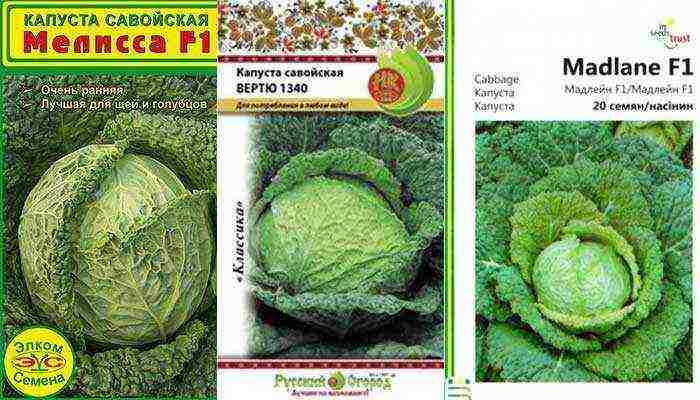
Photo of Savoy cabbage Melissa F1, Vertue 1340 F1, Madlane F1
Among the well-known and widespread varieties are also distinguished: "Kornalin F1", "Virosa F1", "Classic", "Vertus", "Alaska F1", "Zolotaya early", "Ovasa F1" and others.
How to grow and care outdoors?
In cultivation, Savoy cabbage is quite simple. It is grown in the same way as white cabbage; the methods are not much different. It is usually grown by the seedling method, but in the southern regions, you can sow seeds directly to a permanent place in a greenhouse or open ground. If seedlings are made, then they are grown at home for about a month (until 5 leaves appear), then they are hardened and only after that they are transplanted to a permanent place.
Follow-up care includes timely watering, feeding, removing weeds from the garden, hilling, spraying from pests and diseases. The positive quality of this type of cabbage is that it is more cold-resistant than white cabbage and can withstand recurrent spring frosts or significant cold snaps, temperature changes throughout the summer.
It makes no sense to describe more detailed instructions for growing, since depending on the variety of Savoy cabbage, the planting time, the temperature of seed germination, the abundance of watering, the place for planting, feeding and similar moments differ.
How to choose and store Savoy cabbage correctly?
When buying savoy cabbage, you need to adhere to some rules so that at home, having cut it, you can see a fresh head, and not a sluggish or spoiled one.
- The heads of cabbage should be soft, not very dense, give in under pressure.
- The shape is always round. It is better not to take strange, elongated or bent heads.
- If the upper leaves have spoilage, rot, then it can be bad inside too.
- The color is only green, in different shades, always uniform with pronounced white veins.
If the hostess acquires several heads of cabbage at once or even a whole net, it is important for her to know how to store the Savoy cabbage so that it does not spoil for a long time.
- It is a delicate variety, so it loses moisture quickly. To reduce fluid loss, wrap it in plastic wrap and place it in the refrigerator compartment in the vegetable compartment. In this form, it will be fresh for at least 3-4 days.
- Early varieties of Savoy cabbage are not stored for a long time, but medium-late and late varieties can lie for 4-6 months in the cellar. They differ in darker upper leaves.
- If you need to store savoy cabbage harvested from the garden, then for this they look for a dark room with a temperature of 0 ... + 3 degrees Celsius and a humidity of 90%.It is recommended to put cabbage in boxes (wooden) or nets suspended from the ceiling.
- For the winter, cabbage should be frozen, in this form it is stored for up to a year.
- Interestingly, Savoy cabbage is often dried. To do this, it is shredded, laid out in one layer and dried at a temperature of + 50 ... 60 degrees in an electric dryer or oven. Dried Savoy cabbage does not lose its beneficial properties for up to 2 years! True, its color darkens, but in dishes it becomes lighter, more pleasant.


